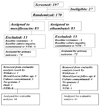Moxifloxacin versus ethambutol in the initial treatment of tuberculosis: a double-blind, randomised, controlled phase II trial
- PMID: 19345831
- PMCID: PMC2866651
- DOI: 10.1016/S0140-6736(09)60333-0
Moxifloxacin versus ethambutol in the initial treatment of tuberculosis: a double-blind, randomised, controlled phase II trial
Abstract
Background: New treatments are needed to shorten the time required to cure tuberculosis and to treat drug-resistant strains. The fluoroquinolone moxifloxacin is a promising new agent that might have additive activity to existing antituberculosis agents. We assessed the activity and safety of moxifloxacin in the initial stage of tuberculosis treatment.
Methods: We undertook a phase II, double-blind, randomised controlled trial of a regimen that included moxifloxacin in adults with sputum smear-positive tuberculosis at one hospital in Rio de Janeiro, Brazil. 170 participants received isoniazid, rifampicin, and pyrazinamide at standard doses and were assigned by permuted block randomisation to receive either moxifloxacin (400 mg) with an ethambutol placebo (n=85) or ethambutol (15-20 mg/kg) plus moxifloxacin placebo (n=85) 5 days per week for 8 weeks. The primary endpoint was the proportion of patients whose sputum culture had converted to negative by week 8. Analysis was by modified intention to treat (ITT); patients whose baseline cultures were negative, contaminated, or contained drug-resistant Mycobacterium tuberculosis were excluded from the analysis. Additionally, all missing 8-week results were deemed treatment failures. This study is registered with ClinicalTrials.gov, number NCT00082173.
Findings: 74 patients assigned to the moxifloxacin group and 72 in the ethambutol group were included in the modified ITT population. 125 patients had 8-week data (moxifloxacin n=64, ethambutol n=61); the main reason for absence of data was culture contamination. At 8 weeks, culture conversion to negative had occurred in 59 (80%) of 74 patients in the moxifloxacin group compared with 45 (63%) of 72 in the ethambutol group (difference 17.2%, 95% CI 2.8-31.7; p=0.03). There were 16 adverse events (eight in each group) in 12 patients. Only one event was judged related to study drug (grade 3 cutaneous reaction in the ethambutol group).
Interpretation: Moxifloxacin improved culture conversion in the initial phase of tuberculosis treatment. Trials to assess whether moxifloxacin can be used to shorten the duration of tuberculosis treatment are justified.
Conflict of interest statement
None of the authors reports any conflicts of interest with respect to this study.
Figures
Comment in
-
Crunch time for tuberculosis control.Lancet. 2009 Apr 4;373(9670):1145. doi: 10.1016/S0140-6736(09)60662-0. Lancet. 2009. PMID: 19345812 No abstract available.
-
Fourth-generation fluoroquinolones in tuberculosis.Lancet. 2009 Apr 4;373(9670):1148-9. doi: 10.1016/S0140-6736(09)60559-6. Lancet. 2009. PMID: 19345815 No abstract available.
-
Moxifloxacin versus ethambutol in initial tuberculosis treatment.Lancet. 2009 Jun 27;373(9682):2197-8; author reply 2198-9. doi: 10.1016/S0140-6736(09)61188-0. Lancet. 2009. PMID: 19560596 No abstract available.
References
-
- World Health Organization. Global tuberculosis control 2008 - surveillance, planning, financing. WHO/HTM/TB/2008.393. Geneva: 2008.
-
- Gillespie SH, Billington O. Activity of moxifloxacin against mycobacteria. J Antimicrob Chemother. 1999;44(3):393–395. - PubMed
Publication types
MeSH terms
Substances
Associated data
Grants and funding
LinkOut - more resources
Full Text Sources
Other Literature Sources
Medical



